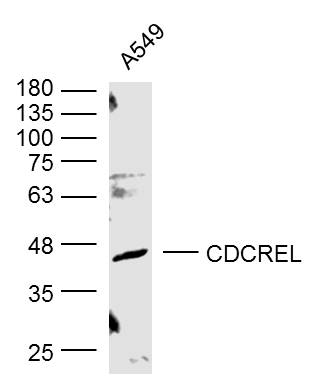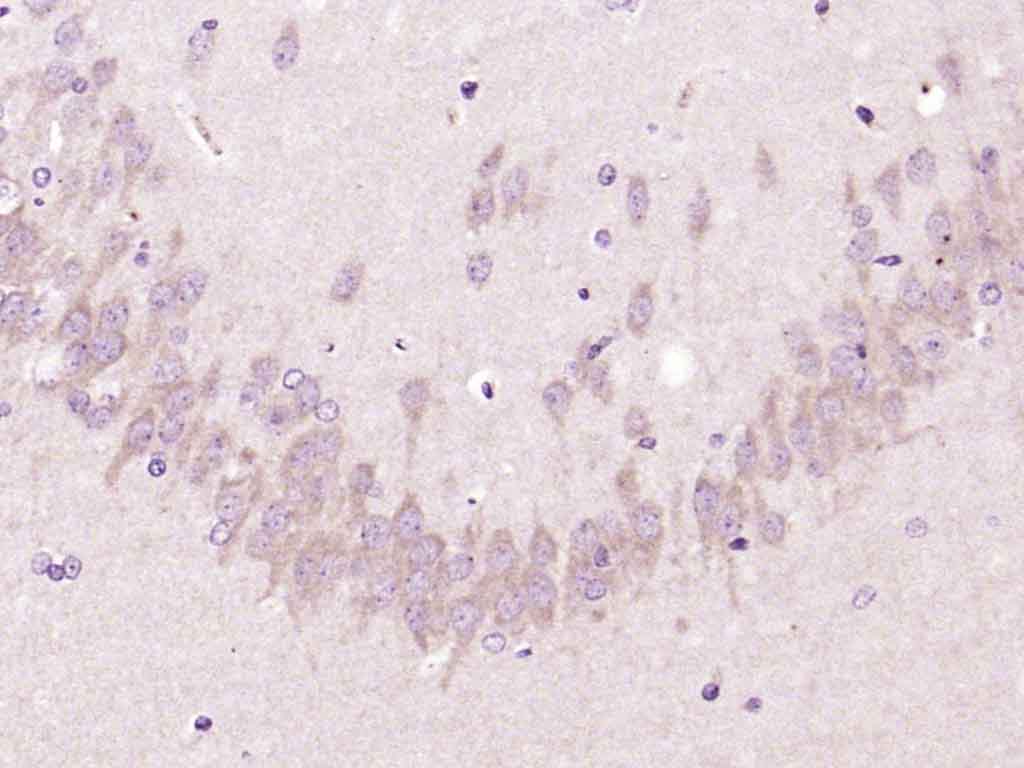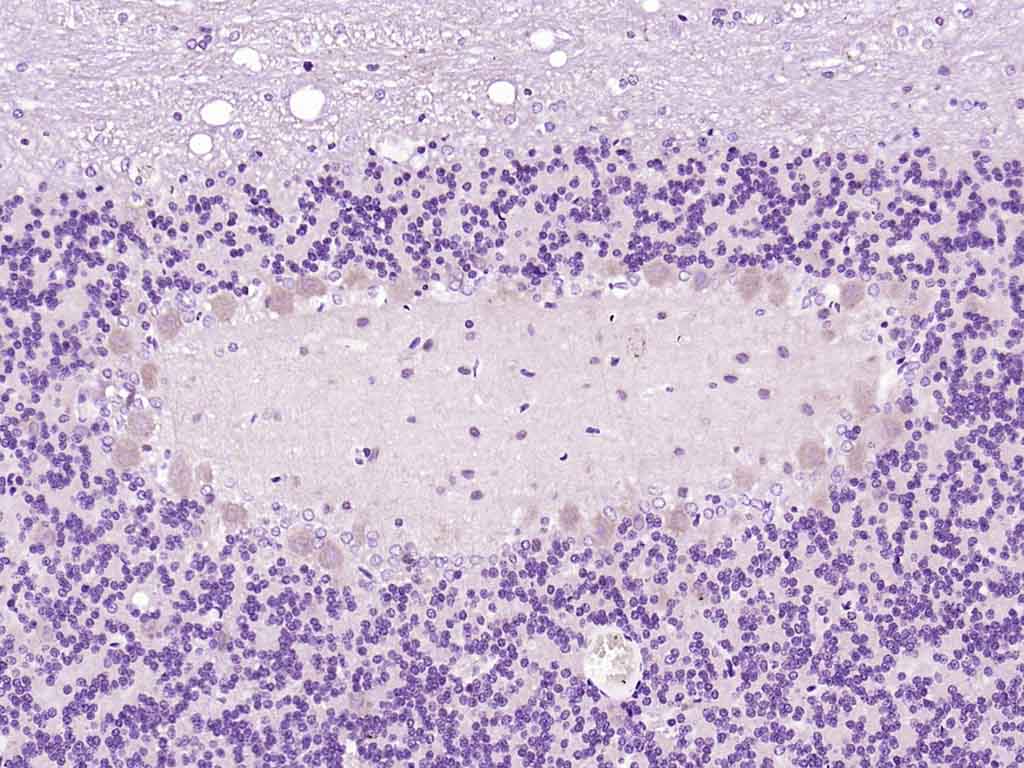
Rabbit Anti-CDCREL antibody
5 Sep; CDCrel-1; Cell division control related protein 1; Cell division control-related protein 1; H5 antibody HCDCREL 1; Peanut like 1; Peanut like 1 homolog; Peanut like protein 1; Peanut-like protein 1; Platelet glycoprotein Ib beta chain; PNUTL1; SEPT
View History [Clear]
Details
Product Name CDCREL Chinese Name 细胞周期调控相关蛋白1抗体 Alias 5 Sep; CDCrel-1; Cell division control related protein 1; Cell division control-related protein 1; H5 antibody HCDCREL 1; Peanut like 1; Peanut like 1 homolog; Peanut like protein 1; Peanut-like protein 1; Platelet glycoprotein Ib beta chain; PNUTL1; SEPT5; SEPT-5; SEPT 5; SEPT5_HUMAN; Septin 5; Septin5; Septin-5. Research Area Cell biology immunology Cyclin Cell differentiation Cytoskeleton Immunogen Species Rabbit Clonality Polyclonal React Species Human, Rat, (predicted: Mouse, Dog, Pig, Cow, Horse, ) Applications WB=1:500-2000 ELISA=1:5000-10000 IHC-P=1:100-500 IHC-F=1:100-500 IF=1:100-500 (Paraffin sections need antigen repair)
not yet tested in other applications.
optimal dilutions/concentrations should be determined by the end user.Theoretical molecular weight 41kDa Cellular localization cytoplasmic Form Liquid Concentration 1mg/ml immunogen KLH conjugated synthetic peptide derived from human CDCREL/SEPT5: 21-120/369 Lsotype IgG Purification affinity purified by Protein A Buffer Solution 0.01M TBS(pH7.4) with 1% BSA, 0.03% Proclin300 and 50% Glycerol. Storage Shipped at 4℃. Store at -20 °C for one year. Avoid repeated freeze/thaw cycles. Attention This product as supplied is intended for research use only, not for use in human, therapeutic or diagnostic applications. PubMed PubMed Product Detail This gene is a member of the septin gene family of nucleotide binding proteins, originally described in yeast as cell division cycle regulatory proteins. Septins are highly conserved in yeast, Drosophila, and mouse and appear to regulate cytoskeletal organization. Disruption of septin function disturbs cytokinesis and results in large multinucleate or polyploid cells. This gene is mapped to 22q11, the region frequently deleted in DiGeorge and velocardiofacial syndromes. A translocation involving the MLL gene and this gene has also been reported in patients with acute myeloid leukemia. Alternative splicing results in multiple transcript variants. The presence of a non-consensus polyA signal (AACAAT) in this gene also results in read-through transcription into the downstream neighboring gene (GP1BB; platelet glycoprotein Ib), whereby larger, non-coding transcripts are produced. [provided by RefSeq, Dec 2010].
Function:
Filament-forming cytoskeletal GTPase. May play a role in cytokinesis (Potential). May play a role in platelet secretion.
Subunit:
Septins polymerize into heterooligomeric protein complexes that form filaments, and can associate with cellular membranes, actin filaments and microtubules. GTPase activity is required for filament formation. Interacts with SEPT2 and SEPT5. In platelets, associated with a complex containing STX4. Interacts with PARK2. This interaction leads to SEPT5 ubiquitination and degradation.
Subcellular Location:
Cytoplasm. Cytoplasm, cytoskeleton. Note=In platelets, found in areas surrounding alpha-granules
Tissue Specificity:
Expressed at high levels in the CNS, as well s in heart and platelets (at protein level).
Post-translational modifications:
In platelets, phosphorylated in response to thrombin, phorbol-12-myristate-13-acetate and collagen.
Similarity:
Belongs to the septin family.
SWISS:
Q99719
Gene ID:
5413
Database links:
UniProtKB/Swiss-Prot: Q99719.1
SEPTIN(SEPT)家族是Cytoskeleton蛋白的一种,具有GTPase的活性。经研究发現,SEPT参与细胞的分裂、The cell membrane的运输以及构成Cytoskeleton。SEPTIN5又称Cytoskeleton蛋白SEPT5。Product Picture
A549 Cell (Human) Lysate at 30 ug
Primary: Anti- CDCREL (SL6905R) at 1/300 dilution
Secondary: IRDye800CW Goat Anti-Rabbit IgG at 1/20000 dilution
Predicted band size: 41 kD
Observed band size: 46 kD
Paraformaldehyde-fixed, paraffin embedded (rat brain); Antigen retrieval by boiling in sodium citrate buffer (pH6.0) for 15min; Block endogenous peroxidase by 3% hydrogen peroxide for 20 minutes; Blocking buffer (normal goat serum) at 37°C for 30min; Antibody incubation with (CDCREL) Polyclonal Antibody, Unconjugated (SL6905R) at 1:200 overnight at 4°C, followed by operating according to SP Kit(Rabbit) (sp-0023) instructionsand DAB staining.Paraformaldehyde-fixed, paraffin embedded (rat cerebellum); Antigen retrieval by boiling in sodium citrate buffer (pH6.0) for 15min; Block endogenous peroxidase by 3% hydrogen peroxide for 20 minutes; Blocking buffer (normal goat serum) at 37°C for 30min; Antibody incubation with (CDCREL) Polyclonal Antibody, Unconjugated (SL6905R) at 1:200 overnight at 4°C, followed by operating according to SP Kit(Rabbit) (sp-0023) instructionsand DAB staining.
References (0)
No References
Bought notes(bought amounts latest0)
No one bought this product
User Comment(Total0User Comment Num)
- No comment





 +86 571 56623320
+86 571 56623320
 +86 18668110335
+86 18668110335

